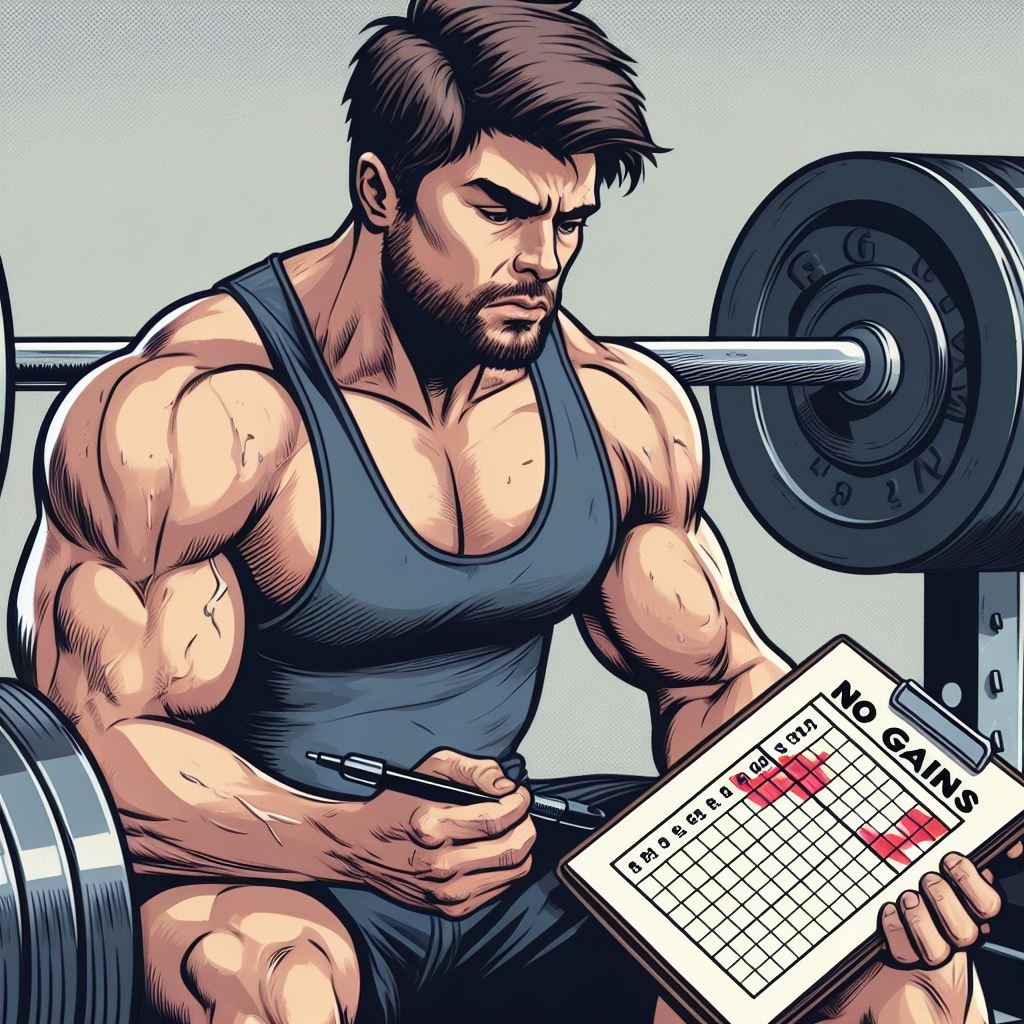OVERCOMING TRAINING PLATEAUS

TABLE OF CONTENTS
- Introduction
- Understanding What A Plateau Is
- Causes Of Plateau’s
- Ways to Overcome a Plateau
- Preventing Future Plateaus
- Conclusion
INTRODUCTION:
Every weight lifter knows the exhilarating feeling of progress, that feeling where every workout you’re setting new personal records on at least 1 lift. The unstoppable hulk inside your growing out of control, seeing bigger weights on the bar, and the satisfying exhaustion after a challenging workout, and yes the thrill of a 1 rep max (1RM) attempt where you set a new personal record (PR)n.
But what happens when that progress stalls?
Welcome to the dreaded weightlifting plateau, a frustrating phase where despite your best efforts, you seem to hit a wall and your strength gains just stop. Weeks or months go by and your workouts look and feel the same, it’s very deflating.
Fear not! Plateaus are a natural part of the journey, and with the right strategies, you can overcome them and get back on track towards setting new personal records in the gym!
UNDERSTANDING WHAT A PLATEAU IS
First, let’s define what a training plateau is. Essentially, it’s a period where your progress stagnates, and you find it challenging to increase the amount of weight you can lift or the number of repetitions you can perform. It’s a lot like running in place. You’re putting the work in but not seeing the results of your efforts.
Usually a plateau is a sign that something isn’t working and it’s time to take a step back and evaluate your overall training, nutrition, and recovery plan and find the weak link so you can start the next leg of your strength journey.
CAUSES OF A PLATEAU
Several common factors can contribute to hitting a plateau in weightlifting.
Common factors are.
Overtraining
Inadequate recovery
Poor nutrition
Lack of workout variation in your workout routine
Other psychological factors such as stress and burnout can all play a role.
Additionally, your body might simply have adapted to your current training regimen, making further gains difficult without introducing changes to force your body to response such as changing your nutrition and training plan.
WAYS TO OVERCOME A PLATEAU:
1 REASSESS YOUR PROGRAM
Take a critical look at your current workout routine. Are you overtraining certain muscle groups? Are you neglecting others? Consider adjusting your program to target different muscle fibers or introduce new exercises to challenge your body in new ways.
One great way to do this is to add some axillary movements in that work similar muscle groups.
Lets say you’ve plateaued on your bench press. Incorporating different exercises may help strengthen the bottle neck that’s holding you back.
Some examples might included:
Dumbbell press for stability work
Incline press for upper chest
Skull crushers for triceps
Flys to work the shoulders
Adding exercises that work related muscle groups in different ways helps stimulate new muscle growth, neurological development, and strengthen muscle connecting tissues important for an all out effort such as a 1 rep max.
2 MODIFY INTENSITY AND VOLUME
Sometimes, a slight tweak in intensity or volume can make a significant difference. Try increasing the weight and decreasing the number of repetitions (low reps, high weight) or vice versa (high reps, lower weight) to shock your muscles and stimulate growth.
Another way to approach this is by varying the speed of your lifts. For example you might lighten the load on deadlift but focus on exploding off the ground to work on your explosive power critical to a big lift.
Pause reps such at the bottom of a bench press or squat can also stimulate further muscle development by providing additional work in the range of motion that tends to be a lifters sticking point.
3 FOCUS ON TECHNIQUE
Perfecting your form can make a world of difference in your lifting performance.
Your body will perform much better when you properly execute a lift. Everything from your posture, breathing, and motion matters.
For some general tips check out our Training Tips sections for some useful pointers.
If you’re a somewhat experienced lifter you may consider lifting in front of a mirror or taking a video clip of your lift from different angles so you can evaluate your form for any issues.
Sometimes it’s obvious when you take a look. It’s hard to fix what you can’t see.
If your new to lifting or you’ve been stuck for a while it might be worth consulting with a qualified coach or trainer to ensure you’re performing each exercise correctly, maximizing muscle engagement, and minimizing the risk of injury.
4 PRIORITIZE RECOVERY
Adequate rest and recovery are just as crucial as the time you spend lifting weights. When we workout we effectively tear down our muscles so it can be rebuilt stronger. If we don’t provide the time and proper building materials your body won’t be able to make the needed growth.
Make sure you’re getting enough sleep, staying hydrated, and fueling your body with nutritious foods to support muscle repair and growth.
Recovery and nutrition are so important to leveling up your lifting game that we have dedicated section on this site for these topics. I encourage you to review them and make adjustments where needed.
5 DELOAD PERIODS
Sometimes, giving your body a break from heavy lifting can be precisely what it needs to overcome a plateau. Incorporate deload weeks into your training program, where you reduce the intensity and volume of your workouts to allow your muscles and central nervous system to recover fully.
Generally speaking most athletes will need a deload week every 3 months or so. even though you have rest days your body will eventually wear down due to the accumulated effects of stress from a rigorous progressive overload program. A deload week lets you recover from this cumulative effect.
For more information about deload weeks checkout our section on Deload Weeks
PREVENTING FUTURE PLATEAUS
While hitting a plateau is inevitable at times, there are steps you can take to minimize their occurrence in the future.
1 PERIODIZE YOUR TRAINING
Implement a periodization strategy that includes phases of varying intensity, volume, and focus to keep your body constantly challenged and prevent adaptation.
One way to do this is with a structured training program where your workouts are scheduled out ahead of time and with prescribed exercises, weights, and sets. This ensures the proper amount of volume is utilized during workouts and encourages consistency by have a schedule you need to stick to.
2 LISTEN TO YOUR BODY
Pay attention to signs of overtraining or burnout, such as persistent fatigue, lack of motivation, or decreased performance.
If weights that use to feel light feel like Thor’s hammer and the thought of doing set of 12 in the squat rack is just soul crushing, it’s probably time for a deload week to let your body recover.
If you are persistently fatigued you should also evaluate your nutrition and recovery strategies to ensure you are giving your body every chance to recuperate after hard workouts. Remember losing weight a building muscle is usually very difficult to do at the same time, if you’re on a calorically restrictive diet this may be slowing down your recovery.
If fatigue persist despite adding in recovery, changing your training program, and increasing. your caloric intake, you might need to see a doctor to screen for an underlying health issue that needs to be addressed.
3 STAY CONSISTENT
Consistency is key in weightlifting program. I know I’ve consistently pointed this out thru this site (Pun intended) but it’s true, a consistently executed plan is better than the best plan that isn’t acted on consistantly.
Stick to your workout schedule, prioritize proper nutrition and recovery, and trust in the process—even when progress seems slow.
Don’t just workout when you “feel like it” or “have time” make it a priority and schedule it into your week as an important part of your routine.
CONCLUSION:
Hitting a training plateau can be disheartening, but it’s not the end of the road for your fitness journey. By understanding the causes of plateaus and implementing effective strategies to overcome them, you can break through that wall and continue making strides towards your strength and performance goals. Remember, patience, persistence, and a willingness to adapt are your greatest allies in the pursuit of progress. Keep pushing, and soon enough, you’ll be scaling new heights in your weightlifting journey.

